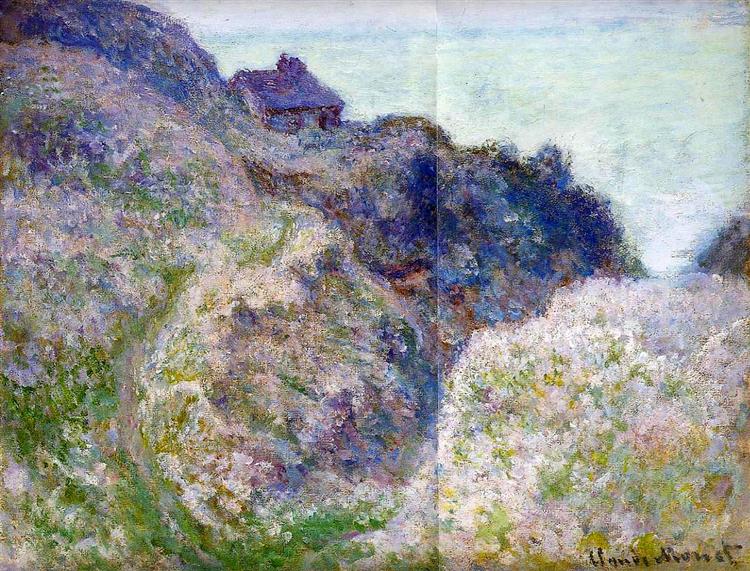Description
Claude Monet's The Coastguard's Cottage at Varengeville (1897) is a fascinating example of the Impressionist style, which the artist helped define and popularize. Set on the Normandy coast, this painting reflects his interest in light, atmosphere, and the depiction of nature in its purest form. Known for his ability to capture the essence of landscapes through his loose, colorful brushstroke technique, Monet makes masterful use of the palette in this work, evoking both the freshness of the sea air and the serenity of the surroundings.
The composition is dominated by the coastguard hut, which stands with a sturdy yet simple presence against the vast backdrop of sea and sky. Monet employs a structure that feels open and breathable, using an angle that allows the viewer to feel the spaciousness of the surrounding landscape. The hut, painted in shades of terracotta red, stands almost like an anchor amidst the shifting surroundings, while the sea unfolds into the background in soft blue and green hues, punctuated with shimmering reflections that suggest the play of light on the waves.
Monet uses a rich colour palette ranging from the most sombre to the most vibrant, capturing natural light and its effect on the landscape. The lower part of the painting, where the land and sea meet, is shaded with dark greens and browns, while the sky shows a subtle transition between greys, blues and whites. This fusion of colours not only reconstructs physical reality, but also conveys a sense of movement and life, so characteristic of Monet's work.
A notable aspect of this work is the absence of human figures, which is a departure from some of the contemporary works of Monet and other artists of his time, who often included characters in their scenes. Instead, the cabin is presented as an isolated entity, inviting the viewer to contemplate not only the beauty of the landscape, but also the solitude that can be experienced in a natural setting. This decision to leave the work free from the distraction of the human figure makes the cabin take on an almost symbolic character, representing the human being's contact with nature and his vulnerability in the face of the immense power of the sea.
The historical context of The Coastguard's Cottage at Varengeville is also of great relevance. Painted during a period when Monet began to explore more deeply his preferred themes around light and its interactions in nature, this work is an extension of his continuing interest in coastal scenes. Monet often spent time on the Normandy coast and the Varengeville area was particularly significant to him, offering endless pictorial possibilities in his constant quest to capture the ephemeral essence of light and colour.
In conclusion, “The Coast Guard’s Hut at Varengeville” is a work that encapsulates Monet’s mastery in the use of color and light, while its composition and choice to depict an environment devoid of human figures achieves a contemplative effect. In this work, the viewer is invited not only to observe the beauty of nature, but to reflect on the impact of the environment on the human experience. With his signature style, Monet does not simply present a landscape, but evokes a sense of peace and reverence towards the natural world, a persistent theme throughout his vast oeuvre.
KUADROS ©, a famous painting on your wall.
Hand-made oil painting reproductions, with the quality of professional artists and the distinctive seal of KUADROS ©.
Painting reproduction service with satisfaction guarantee. If you are not completely satisfied with the replica of your painting, we will refund 100% of your money.

